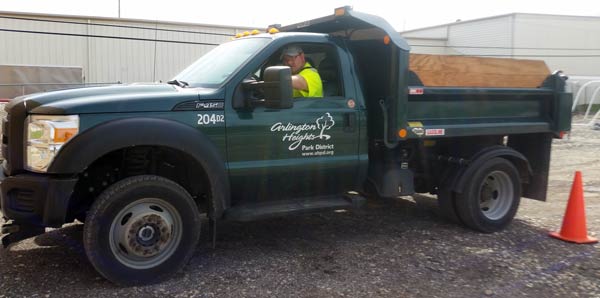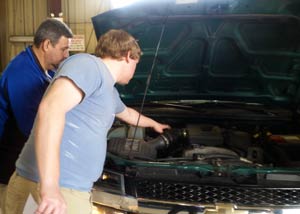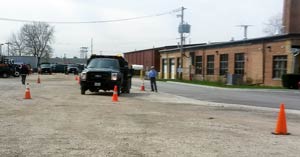 Fleet Safety Combines Maintenance and Training
Fleet Safety Combines Maintenance and Training
Midwest winters can be tough for agencies’ Parks and Facilities staff, but preplanning and preventive maintenance can improve safety and performance throughout the season.
At Elk Grove Park District there’s plenty to do long before the first snowflake hits the ground. A key element, according to Anita Healy, Risk Manager, is preparing the Snow and Ice Removal Operation Plan. The plan is a comprehensive and detailed handbook covering operations, general procedures, safety and much more.
“We review and update our plan for each winter,” says Healy, “and assign roles such as Snow Captains, Snow Teams and Alternates.” The plan includes a snow-plowing priority list, so maintenance and facility staff are on the same page — literally. The plan has timelines, phone numbers, and even includes diagrams for plowing — with special notes about where NOT to put snow.
 In addition to reviewing the plan, preseason preventive maintenance on equipment is a top priority. “We mount controls based on the employees using the equipment — such as joystick options or left-handed/right-handed control preferences — so they can stay behind the wheel to do their jobs instead of having to stop to adjust their equipment,” she explains. Other preseason tasks include changing fluids and checking hydraulics, installing flags on plow blades and hooking the plows to the truck. Not only is the equipment ready, but so are employees, as the agency provides them with personal protective equipment long before snow begins to fall. In addition to reviewing the plan, preseason preventive maintenance on equipment is a top priority. “We mount controls based on the employees using the equipment — such as joystick options or left-handed/right-handed control preferences — so they can stay behind the wheel to do their jobs instead of having to stop to adjust their equipment,” she explains. Other preseason tasks include changing fluids and checking hydraulics, installing flags on plow blades and hooking the plows to the truck. Not only is the equipment ready, but so are employees, as the agency provides them with personal protective equipment long before snow begins to fall.
Arlington Heights Park District also recognizes the value of preventive maintenance in improving fleet safety. “We have a high-quality fleet that’s relatively new and very well maintained,” explains Pat Klawitter, Training and Safety Specialist. “We have two mechanics handling our preventive maintenance schedule, and our procedures allow any employee who thinks a vehicle needs work to drop it off without having to wait for a supervisor’s approval.”
Is staff ready?
 Both Klawitter and Healy encourage members to develop in-house training related to winter topics to ensure employees — as well as the equipment — are ready for the season. Both Klawitter and Healy encourage members to develop in-house training related to winter topics to ensure employees — as well as the equipment — are ready for the season.
“We conduct our Snow and Ice Park District University and cover topics such as salt-and-sand theory, how cold affects the body and strategies for working in it, stretches for drivers and other topics,” explains Healy. “We also walk new staff through our parking lots and walking paths to clarify expectations for plowing, salting, identifying Parks Department and Facilities Department responsibilities as well as service levels. We also ensure only our experienced, full-time staff operates our plow trucks, and we rotate snow teams to prevent fatigue.”
Arlington Heights offers similar training at its Snow Day, held in November. The full-day training begins with staff discussing responsibilities and lessons learned from the previous winter.
“We also meet with our custodians, who do the snow shoveling, to coordinate snow removal with the snowplows. This ensures what they shoveled all morning isn’t tossed back on those same areas later in the day,” Klawitter explains. The afternoon is devoted to a thorough discussion of the snow plan.
Tips to improve fleet safety
Beyond maintenance and training, here are some tips that help Elk Grove and Arlington Heights keep staff and fleets safe and efficient:
- Work in teams. No one does manual winter labor alone; they always work in teams for two-person lifting of the snow throwers off the trucks.
- Prevent fatigue by rotating teams and/or calling in backup.
- Use proper body mechanics when performing activities around or near the snowplow (i.e., shoveling or removing snow from the snowplow).
- Identify specific stretches for the job task and encourage staff to stretch after driving plows and/or shoveling snow.
- Review important information/advice at the beginning of shifts, noting wind chill and current weather conditions.
- Use 360 walk around stickers to remind plow drivers to check the area before beginning work.
- Work with long-term staff to develop your own checklists and procedures.
- Maintain safety by following an improvement process.
PDRMA Resources:
If you have questions or concerns about current signage at your facilities, ask your PDRMA Risk Management Consultant for recommendations and refer to these resources.
|

